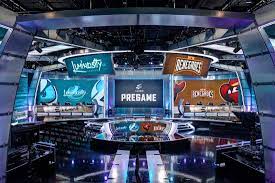TV lighting designs are significant in creating the right atmosphere and mood in your home entertainment space. However, developing these lighting designs can be challenging if you’re unfamiliar with technology tools like light boards and scene files that can help you build your designs quickly and effectively. This article discusses five of the most valuable technology tools for TV lighting designers and how to integrate them into your workflows to streamline your projects.
Robotic Light Fixtures
These fixtures are convenient, lightweight, and easy to use. Their flexibility can help you experiment with design options quickly. They’re also more energy-efficient than traditional lighting systems—a win for your business and your bottom line. If you’re looking to eliminate human error in lighting construction and make decisions faster, a robotic fixture is right for you. You can control a robotic light fixture via a smartphone or tablet app, making it easier to adjust lights on-the-fly while shooting a show or commercial.
That can be especially helpful if you have multiple camera operators working at once. With just a few taps of your screen, you can change color temperature, brightness levels, and other features of your television lighting designto create different looks instantly. This technology helps streamline production and save time during filming. And that means less money spent on production costs overall. Plus, these fixtures are often easy to transport from location to location.
LED Lighting
The television industry is constantly developing new technologies. Some of these innovations make it possible to enjoy a better quality of sound and image than ever before. One of these improvements is LED lighting technology, which can significantly enhance TV brightness without compromising color accuracy. LED lights are particularly beneficial for outdoor stages, where sunlight can be challenging to work with and produce quality results.
LEDs are a smart choice for your next production because they’re highly efficient, long-lasting, and versatile. Whether you’re planning an elaborate outdoor concert or an intimate indoor theater performance, you can use LED fixtures to ensure that your audience gets what they paid for bright, vivid colors that look like they do on screen.
Computer-Controlled Rigger Hoists
You can find these in a variety of sizes and ratings. They are similar to a crane. Due to technological advances, it’s now possible to use a computer-controlled rigger hoist for your lighting needs. Before buying a hoist, ensure that you check if it has slow-motion drives and that its rated load capacity is high enough for your requirements. It will be a good idea to make sure that you calculate how much weight your rigger hoist can hold before finalizing any purchases.
Computer-controlled rigger hoists provide an easy way to raise and lower lighting equipment without any physical effort on your part. These hoists have become more popular because they enable users to save time and energy when lifting heavy loads such as lights, reflectors, or even large pieces of scenery. Another advantage is that you don’t need anyone else to help you lift heavy objects with a computer-controlled rigger hoist.
Use of 3D Tools Rendering
3D tools are extremely useful in architectural and product design, but they also make waves in television lighting design. Whether using a 3D rendering package for real-time animations or creating a realistic model of your lighting, 3D graphics software is more important than ever. 3D rendering tools are some of the most critical software used by professional TV lighting designers. It helps them create a realistic image of how their design will look once installed.
3D rendering tools allowlighting designers to get an idea of their design’s appearance before working on it. The software also helps them to understand and analyze different aspects of their design so that they can improve upon it and make it better. With 3D rendering tools, professionals can easily see if their design works well with its surroundings or not.
If there are any flaws in their design, they can fix them immediately without going through a lengthy process of trial and error. Professionals who use these tools have found that they save themselves a lot of time because there is no need for constant backtracking and redoing things over again.
Light Boards
One of these is a light board, a simple hand-held device that can add accent lighting to your work. Light Boards areincredibly portable and affordable—ensure you have at least one or two on hand when working with clients, particularly if you plan to use video lights. Placing them strategically in each room you shoot in will add depth and dimension to your overall look. You can also use it for highlighting parts of our face such as the eyes, nose, or lips.
Conclusion
The right kind of lighting will make all your hard work look great. Don’t be fooled into thinking that you can get away with a basic, average light; it will show in your final product. Having a fancy camera and lavalier mic doesn’t mean much if you don’t have complementary lights to highlight them. However, with some technology on your side, you can take some serious strides forward. You can craft a high-quality product for yourself and your audience. Hiring an experienced lighting designing company is crucial to making your TV production a hit!








